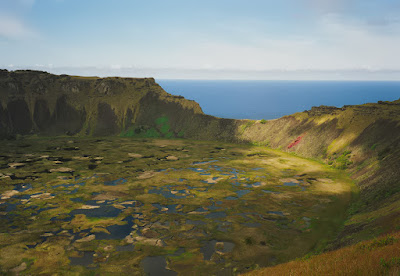29 Aug 2002
First stop, Easter Island! (aka Rapa Nui or Isla de Pascua)
As the most isolated inhabited island in the world, it's not particularly easy to get to. I had a fancy round-the-world ticket which was only valid with a selection of airlines, so rather than take the direct route via Tahiti, I flew all the way to Santiago in Chile, then promptly jumped on a plane and flew a third of the way back across the Pacific Ocean. The upshot of this was that we were heading west at dusk, chasing the sun over the horizon for a glorious extended sunset.
 |
| View over Hanga Roa |
On the first non-travelling day of my big adventure I walked from the main town of Hanga Roa to the ceremonial village of Orongo which is perched on the edge of one of the island's three volcanoes. One side slopes steeply down into a water-filled crater, and the other drops precipitously to the ocean. Apparently the original Polynesian inhabitants would slide (careen?) down the crater walls on banana leaves. There was also an annual competition to swim out to a group of offshore islands. The first to find a bird's egg and return would be honoured as Birdman and have his achievement immortalised in petroglyphs. This is a genuinely impressive feat, as they would have had to dive off huge cliffs into wild seas, then swim a kilometre there and back.
 |
| Ranu Kao |
At Orongo I had my first experience of not being able to speak the local language. The ranger said something to me in rapid Chilean Spanish, and I was dumbstruck. I had no idea what she'd said, and with mouth agape, couldn't even begin to phrase a response. I'd spent a few months learning Spanish, at night college and with teach-yourself books and tapes, but I was desperately under-prepared for the real thing. I couldn't even bring myself to say "No hablo espanol". Luckily, another person there spied my predicament and had some English, so was able to help me out. I felt completely out of my depth, dumb, inadequate, even disabled - a salutary lesson (as my dad liked to say, repeatedly, "Training for life, son.")
 |
| Motu Kao Kao, Iti & Nui, viewed from Orongo. Petroglyphs in foreground. |




